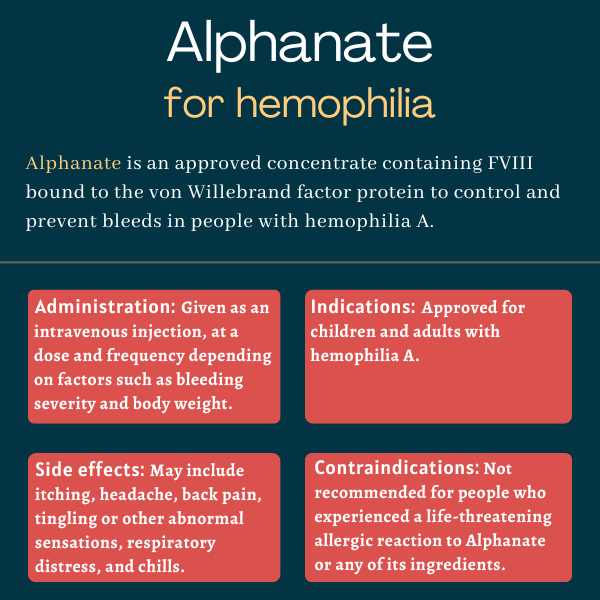Alphanate (human antihemophilic factor/von Willebrand factor complex) for hemophilia
Last updated June 17, 2024, by Margarida Maia, PhD

What is Alphanate for hemophilia?
Alphanate (human antihemophilic factor/von Willebrand factor complex) is an injection therapy to prevent and control bleeds, including those occurring during surgery, in children and adults with hemophilia A.
The medication contains a concentrate of two proteins bound together — clotting factor VIII (FVIII) and von Willebrand factor. It is prepared from pooled human plasma, and is administered via an intravenous, or into-the-vein, injection.
Marketed by Grifols, Alphanate is also approved for another blood-clotting disease called von Willebrand disease.
Therapy snapshot
| Brand name: | Alphanate |
| Chemical name: | Human antihemophilic factor/von Willebrand factor complex |
| Usage: | Prevention and treatment of bleeding episodes, including those occurring during surgery, in hemophilia A |
| Administration: | Intravenous injection |
How does Alphanate work in hemophilia?
Hemophilia A is caused by mutations leading to a missing or faulty FVIII, a clotting protein found in the blood. Without FVIII, the blood cannot clot normally, causing people with hemophilia A to experience excessive bleeding occurring either spontaneously or following an injury or surgery.
Alphanate contains the FVIII and von Willebrand factor proteins bound together in a complex, which is how they are naturally found in circulation. von Willebrand factor is needed for platelets to stick together to form a clot, but the protein also plays the primary function of stabilizing FVIII and protecting it from degradation, helping the clotting factor stay active for about four times longer in the blood.
By delivering the FVIII protein to patients, Alphanate can be used as a replacement therapy to temporarily make up for the missing or faulty FVIII, thereby helping to prevent and control bleeds in hemophilia A patients.
Who can take Alphanate?
Alphanate was approved by the U.S. Food and Drug Administration in 1978 for the prevention and control of bleeding episodes, including those occurring during and after surgical procedures, in children and adults with hemophilia A.
Who should not take Alphanate?
Alphanate is contraindicated, or not recommended, for people who previously experienced immediate life-threatening allergic reactions, including anaphylaxis, to the medication or any of its ingredients, including human albumin, arginine, and histidine.
How is Alphanate administered in hemophilia?
Alphanate is given as a slow infusion directly into the bloodstream and can be self-administered after proper training and supervision by an experienced hemophilia doctor.
The concentrate solution is available in single dose vials containing a powder that must be diluted in the appropriate volume of sterile water. It comes in five color-coded strengths:
- a gray box containing a single dose vial with 250 international units (IU) of FVIII plus a vial with 5 mL of sterile water for injection
- a green box containing a single dose vial with 500 IU of FVIII and 5 mL of sterile water
- a blue box containing vials with 1,000 IU of FVIII plus 10 mL of sterile water
- an orange box containing vials with 1,500 IU of FVIII plus 10 mL of sterile water
- a magenta box containing vials with 2,000 IU of FVIII plus 10 mL of sterile water.
All strengths are packaged with a Mix2Vial needle-free transfer device that allows for an easy reconstitution, or dilution, process. When mixed together, powder and diluent create a clear solution that is ready to infuse within three hours of reconstitution.
Alphanate is given as a slow intravenous infusion at no more than 10 mL per minute to avoid vasomotor reactions, or rapid alterations to the diameter of blood vessels.
How much is given depends on factors such as the patient’s body weight and overall clinical condition, the location and severity of the bleeding episode, and the severity of the FVIII deficiency.
For on-demand treatment of bleeds, and until bleeding is resolved, hemophilia A patients should be given Alphanate to maintain FVIII activity levels at:
- 30% of normal in the case of a minor bleeding episode (e.g., large bruises or significant cuts or scrapes). Patients should be given a 15 IU/kg dose of the medication twice daily for 1-2 days in these instances.
- 50% of normal in the case of a moderate bleeding episode (e.g., oral bleeds or dental extractions). Patients should receive 25 IU/kg of Alphanate twice daily for about 2-7 days.
- 80%-100% of normal in the case of a major bleeding episode (e.g., joint or muscle bleeds, major trauma, or brain bleeding). In these cases, patients should receive an initial dose of 40-50 IU/kg and maintenance doses of 25 IU/kg twice daily for at least 3-5 days. A brain bleed may also require prophylactic (preventive) treatment for up to six months.
- 80%-100% of normal in the case of surgical procedures. Patients should receive a single dose of 40-50 IU/kg. Then, for the next 7-10 days, or until healing is achieved, Alphanate should be given at a dose of 30-50 IU/kg twice daily to maintain FVIII activity levels at 60%-100% of normal.
A travel kit is available for patients enrolled in Grifols’ Factors for Health program. Dubbed the Grifols Gear travel kit, it is designed to make it easier for patients to carry all the supplies needed for on-the-go infusions.

Alphanate in hemophilia clinical trials
The safety of Alphanate in hemophilia A was assessed in a prospective clinical study, where a total of 23 patients received a median of 42 infusions. The total number of infusions in this study was 1,217, and patients were exposed to Alphanate for a total of 1,133 days.
Over a total of 19.5 years of follow-up across all participants, no adverse drug reactions or neutralizing antibodies (inhibitors) against FVIII, which may prevent the treatment from working, were reported.
The therapy’s safety was also evaluated in studies conducted after its approval.
A Phase 4 trial (NCT00323856) in Poland tested the medication in 50 boys and men, ages 6 to 65, with severe hemophilia A. None of the patients developed FVIII inhibitors. Over up to 30 months of treatment, or about 2.5 years, 22 patients (44%) experienced side effects, the most common being cough, throat pain, and upper respiratory tract infection. Four (8%) experienced serious side effects.
Similar findings were obtained during post-marketing surveillance in the U.S., where none of the side effects reported were considered related to treatment.
Common side effects of Alphanate
The most common side effects that have been reported with Alphanate include:
- itching (pruritus)
- headache
- back pain
- tingling or other abnormal sensations (paresthesia)
- respiratory distress
- swelling in the face
- pain
- rash
- chills.
Allergic reactions
Severe allergic reactions, including anaphylaxis, may occur with Alphanate, with early symptoms including swelling under the skin, chest tightness, low blood pressure, nausea, vomiting, restlessness, and shortness of breath.
If symptoms suggestive of an allergic reaction develop, the medication should be stopped and appropriate treatment should be given to patients.
Development of inhibitors
People on Alphanate and other FVIII-containing products may develop inhibitors against FVIII, which can prevent the therapy from working as intended. If the expected levels of FVIII activity are not reached, or if bleeding is not brought under control with an appropriate dose, a blood test should be done to check for the presence of inhibitors.
Red blood cell destruction
Infusion of large or frequent doses of Alphanate may cause intravascular hemolysis, or the destruction of red blood cells inside blood vessels. This issue normally resolves after discontinuing Alphanate, but some patients may require alternative therapies if the condition worsens after they stop treatment.
Risk of viral infection
Alphanate is made from human plasma, and there is a theoretical risk that it may transmit infectious pathogens, such as viruses or prions (misfolded proteins) that cause Creutzfeldt-Jakob disease. While steps are taken to make it safe, including screening donors and inactivating certain viruses during manufacturing processes, there is still a small chance of the medication carrying infectious agents.
Use in pregnancy and breastfeeding
There are no studies in humans or animals to know whether Alphanate can affect a developing fetus during pregnancy, if it passes into breast milk, or is safe for the breastfed infant.
The medication should only be administered during pregnancy or breastfeeding if it is clearly needed. Thus, patients who are pregnant, planning to become pregnant, and those who are breastfeeding or planning to nurse should discuss this issue with their healthcare provider.
Hemophilia News Today is strictly a news and information website about the disease. It does not provide medical advice, diagnosis, or treatment. This content is not intended to be a substitute for professional medical advice, diagnosis, or treatment. Always seek the advice of your physician or other qualified health provider with any questions you may have regarding a medical condition. Never disregard professional medical advice or delay in seeking it because of something you have read on this website.
Related articles





